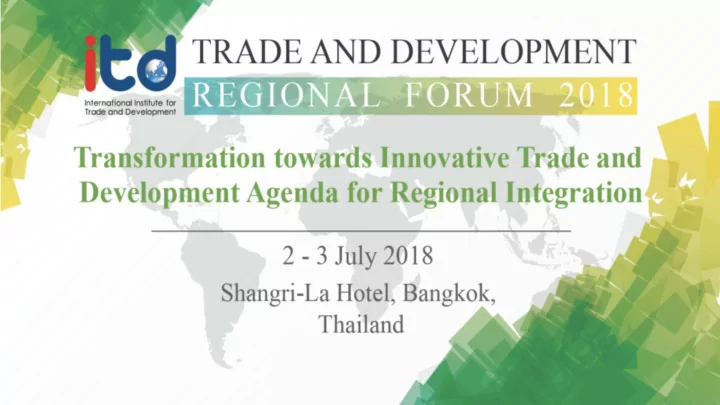

Realiz lizin ing R Regio ional l Integratio ion Goals t throu ough D Digital Trade: The U e UN Perspec ective Session II
Panel O Objective: The objective of the panel is to introduce roles, mandate, on-going initiatives of selected UN agencies active and pro-active in the digital economy in promoting regional integration in Asia Pacific: • what they each do • where they are going • what they are ultimately trying to accomplish • how they can help public and private sector alike
St Structure of of the e sessio session Introduction by the moderator 3 mini-Rounds of exchange 2 surprise questions… Questions and answers session (using sli.do)
Panelists Tengfei Wang David Galipeau Min Jung Kim Duangthip Chomprang Founder and Chief Economic Affairs Legal Expert, of the United Officer UNCITRAL Regional Director, Regional Nations Social Trade, Investment and Centre for Asia and Cooperation and Impact Fund Innovation Division the Pacific Assistance, ITD (UNDP-UNSIF) UNESCAP
We need to hear from you too…
What i is the d digital economy? Digital economy: greater than social media/messaging; greater than tech/e-commerce companies We are talking about the ICT Sector / Digital government / e- Digital Tech Sector government economy capacity to draw on digital technologies as a driver of growth across the whole economy Big challenges in measuring the size and scope – limited data
Digi gital ec econo nomy: per pervasi sive, , di disr sruptive, a e, accel elerating, di diver ersi sifying Capacity to draw on digital “Digital goods” (e.g. • technologies as a driver of growth apps, songs, videos) across the whole economy • Services (e.g. BPO, financial services) Challenge to measure size and scope- Online trade in Online shopping limited data services (goods) Regulations Business mobility Competition policy Online-to- Gig economy Content access offline Data policies Intellectual property rights FDI limits Logistics Online sales and transactions Public procurement Quantitative trade restrictions Payments Standards Tariffs Taxes Connectivity (Digital Infrastructure) x
Types o of El Elect ctronic T Trade • E-Trade : all goods and services (both traditional and digital) traded internationally through electronic means • E-commerce : the purchase of traditional goods and services through digital means • Digital trade : all transactions involving digital goods and services as “digital trade”. 7
Connect ctivi vity: mobile h has grown r rapidly b but fixed broadband l lagging 100 93 Fixed-line broadband subscribers (Per 100 inhabitants, 2016) 87 90 Unique Mobile Broadbnad Subscribers (% of population, 2016) 79 78 80 74 ASEAN 67 70 average 62 speeds vary 60 56 from 15-85% 53 52 of global 50 average 40 Source: Google/Temasek 30 26 20 9 9 8 8 10 3 1 0 0 1 0 Brunei Thailand Myanmar Malaysia Singapore Philippines Indonesia Vietnam Lao PDR Cambodia Darussalam
Technol ology ogy adoption on: A long w g way t to go go i in grow owing b g business use se o of I ICT Firms using e-mail to interact with clients (%) B2B ICT Use B2C ICT Use Myanmar 3.3 3.3 Cambodia, Global India 4.1 4.2 57.5 average, 69.0 Lao PDR 4.3 4.0 Indonesia, Cambodia 4.5 4.0 China, 85.0 30.6 Indonesia 4.9 5.4 Lao PDR, 24.3 Philippines 4.9 4.8 Vietnam 4.9 4.9 Malaysia, China 4.9 5.3 India, 78.0 46.2 Myanmar, Thailand 5.0 5.1 30.1 Global 5.0 4.5 average Thailand, Vietnam, Malaysia 5.7 5.9 52.9 91.5 Philippines, Singapore 5.8 5.5 80.4 Source: WEF Networked Readiness Index firm surveys 1=low Source: World Bank Enterprise Surveys use, 7= high use
Logistics a and t trade f faci cilitation: s some signs of i improvement but still a a major c constraint Need to improve not just domestic connectivity – but also ease of shipping internationally – if e-commerce is going to grow Postal Reliability Index Ease of arranging international shipments 120.0 4.5 4.0 100.0 3.5 80.0 3.0 2.5 60.0 2.0 40.0 1.5 1.0 20.0 0.5 0.0 0.0 Source: UPU Source: World Bank Logistics Performance Index
Cross ss-cutting p policy a and r regulatory infrastruct cture: i it can enable or hinder g growth The challenge for Myanmar: Enabling regulatory Restrictive measures Getting the balance right e-trade policies between enabling and restrictive regulatory Privacy and data measures protection Intermediary liability The opportunity: Regulatory infrastructure is Server Consumer localization protection still largely under requirements development; less “legacy” e-payments issues than other ASEAN Data flows restrictions countries e-signature Ban of electronic online sales Opportunity to benefit from documentation regional experience-sharing and cooperation regulation
What are at are e eTrad Trade Read adine ness Asse ss Assessm ssments nts ? • Objective: to assess countries’ current strengths, weaknesses, gaps and opportunities in the seven policy areas identified by eTrade for all • Methodology: surveys, in-country mission/focus group discussions, report drafting and validation (eTrade for all partners) • Main outcome : identification of priority actions to increase the uptake of e-commerce • Countries covered : - 2017 completed: Cambodia, Bhutan, Samoa, Nepal - 2018 completed: Lao PDR, Liberia, Myanmar - 2018 on-going: Senegal, Solomon Islands, Togo, Uganda, Vanuatu and Zambia
Key fin findin ings – ASEA SEAN L N LDC DCs Lack of a single shared vision for e- commerce development Outdated ecosystem. eTransaction focus Online consumer concerns growing. In place in capitals, mobile-only. Smartphone + Facebook first Curricula outdated. Focus on ICT skills only. Business accelerator and co-working space everywhere 95% COD. Bank offering DFS. Growing FinTech development. ICT risk-prone sector. Venture capitalists and business accelerators Last mile / physical addressing pioneers not here. issues. Deminimis not applied. Cross border paperless trade growing
Panel anel O Objec jecti tive: e: The objective of the panel is to introduce roles, mandate, on-going initiatives of selected UN agencies active and pro-active in the digital economy in promoting regional integration in Asia Pacific: • what they each do • where they are going • what they are ultimately trying to accomplish • how they can help public and private sector alike
Recommend
More recommend